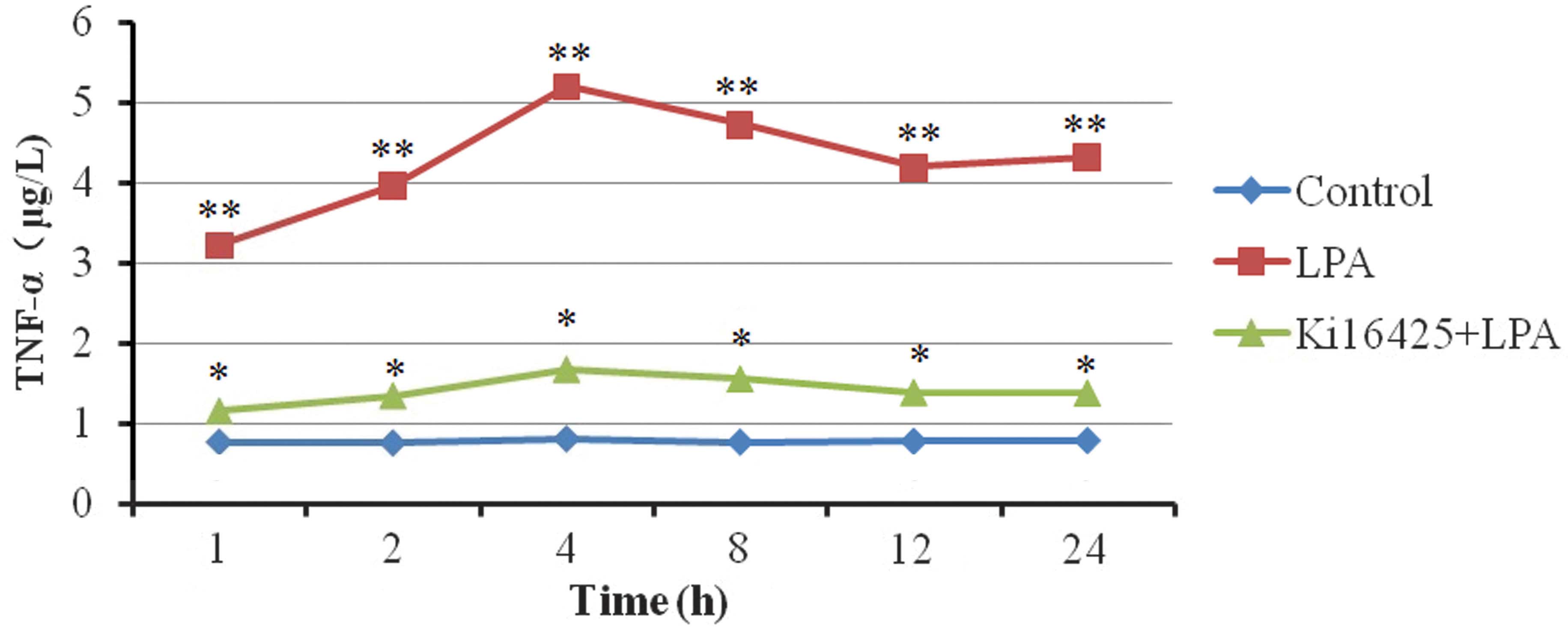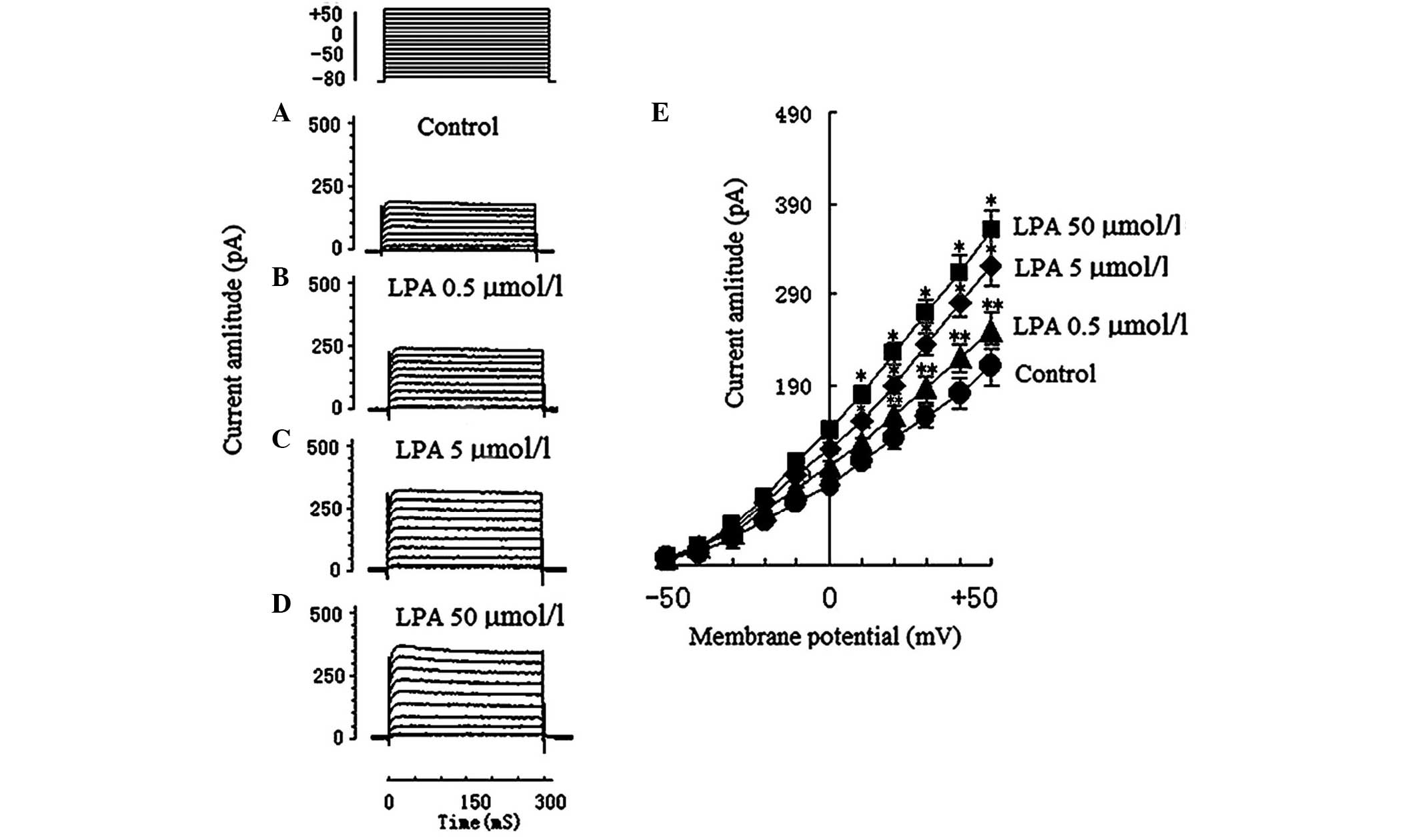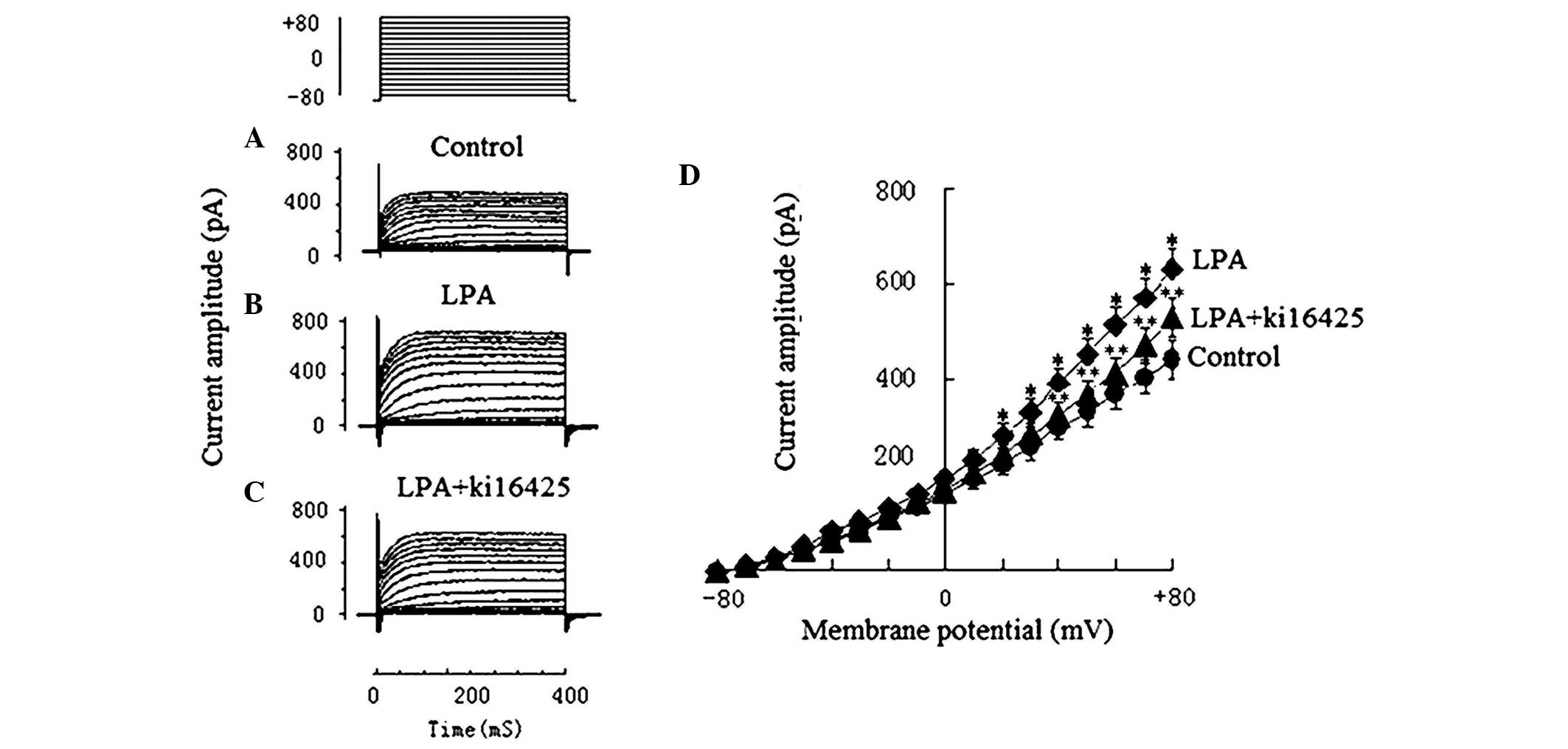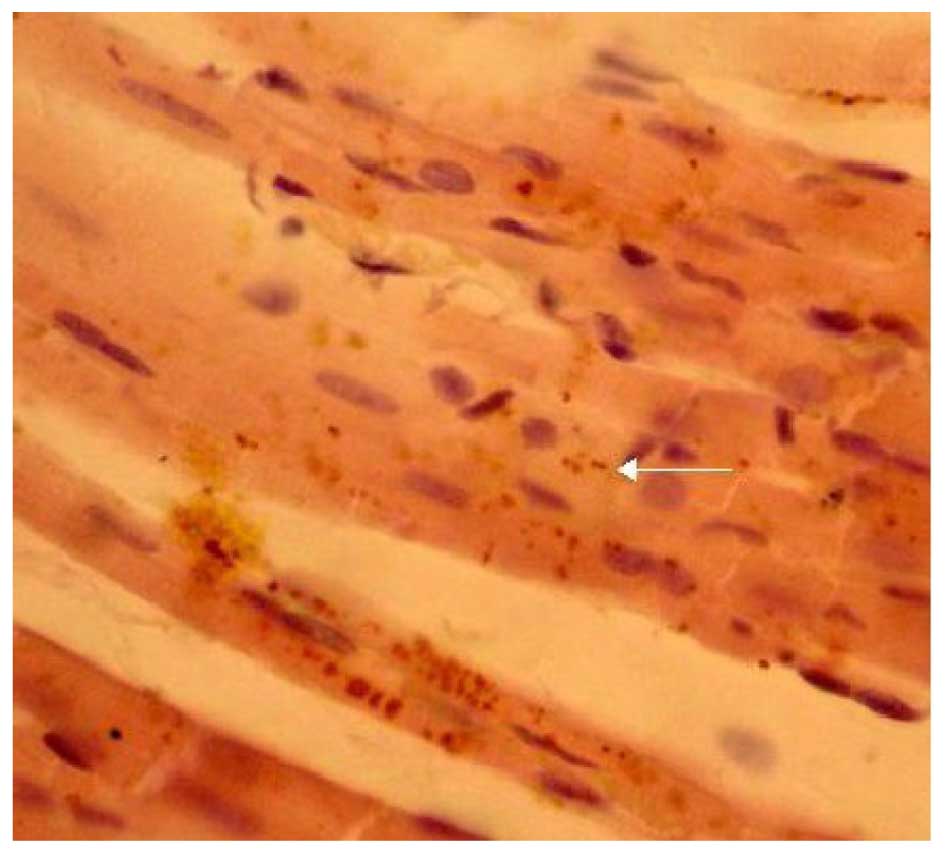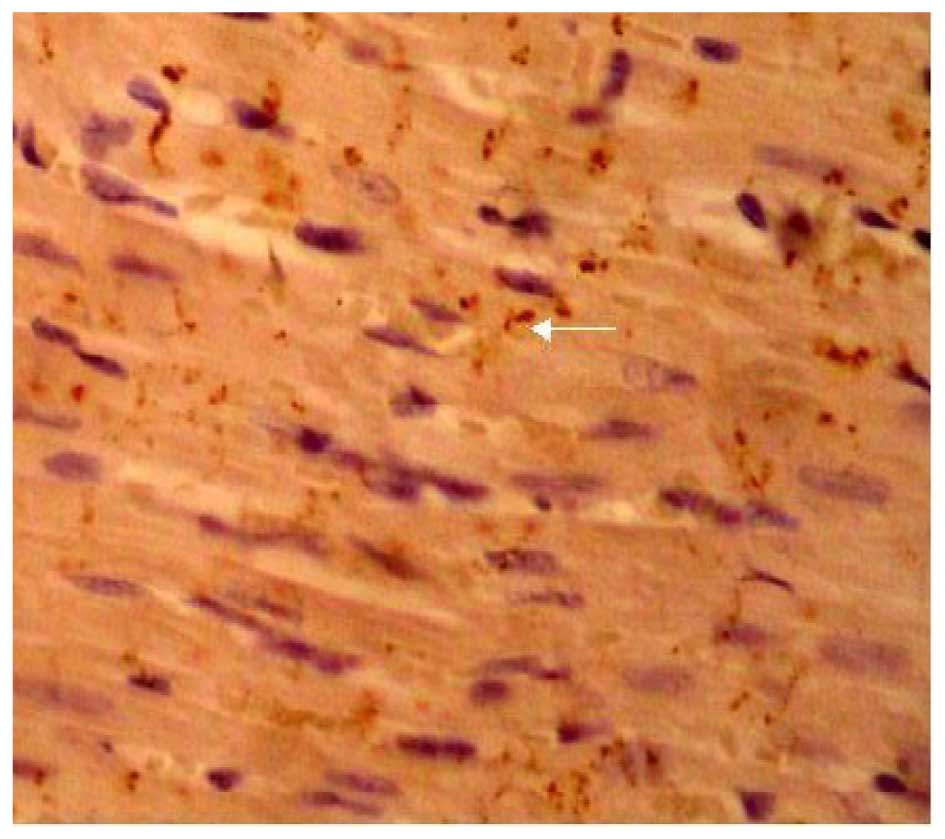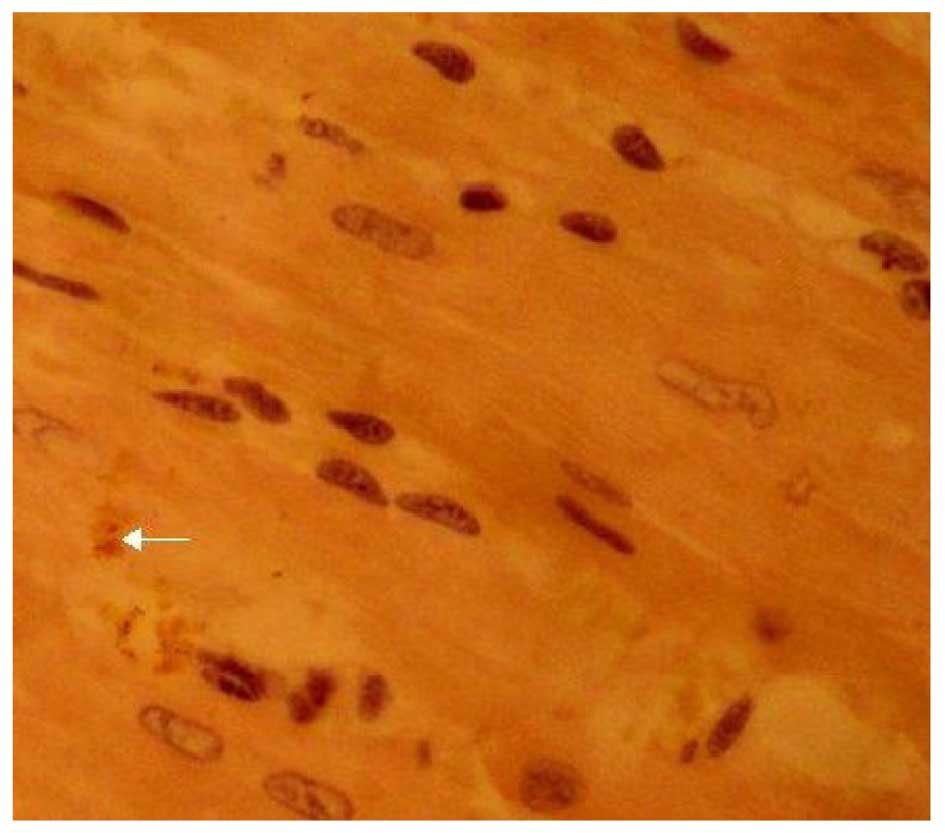Effect of lysophosphatidic acid on the immune inflammatory response and the connexin 43 protein in myocardial infarction
- Authors:
- Published online on: March 9, 2016 https://doi.org/10.3892/etm.2016.3132
- Pages: 1617-1624
Abstract
Introduction
Acute myocardial infarction (AMI) is a disease that severely affects the health and life quality of patients. Arrhythmia is a complication of myocardial infarction, which is one of the most severe cardiovascular diseases, and it is the predominant cause of myocardial infarction-associated mortality (1). Since patients with ischemic heart disease are particularly prone to arrhythmias, they are often admitted for arrhythmia monitoring (2). Lysophosphatidic acid (LPA), which is an intermediate product of membrane phospholipid metabolism, is a lipid mediator with various biological functions that are predominantly mediated by specific G protein-coupled receptors (3). As a water-soluble glycerol phospholipid with a simple structure, LPA is secreted from numerous cell types, including platelets, fibroblasts and ovarian cancer cells (4). The concentration of LPA in regional myocardial tissue and plasma increases during myocardial infarction, and it can also cause arrhythmia (5).
During myocardial infarction, both the infarcted area and the non-infarcted area exhibit perivasculitis, and the infiltration of a large number of inflammatory cells can be observed (6,7). A variety of inflammatory factors, including interferon-γ, interleukin (IL)-4, IL-5, IL-6, IL-8 and IL-10, increase in the peripheral blood, indicating that myocardial infarction is a non-infectious immune inflammatory process (8,9). The immune inflammatory response has an important role in myocardial infarction (10,11). Numerous studies have focused on the effect of LPA on myocardial ischemia, but there are no reports on the immune regulatory effect of LPA on connexin 43 (Cx43) protein expression and arrhythmias (1,4,12). In the present study, various experimental methods were used to observe the effects of LPA on tumor necrosis factor (TNF)-α, Cx43 and potassium channels. The mechanism underlying the LPA-induced induction of arrhythmia was also investigated.
Materials and methods
Experimental animals
A total of 80 healthy adult male and female Wistar rats (clean grade), aged 8–10 week and weighing 240–260 g, were purchased from the Experimental Animal Center of Jilin University (Changchun, China). Rats were maintained in an animal care facility at 21–23°C, relative humidity (55±5%) with a 12-h light/dark cycle and ad libitum access to food and chow for at least three days prior to the initiation of the experiment. The procedures used in the present study were approved by the Animal Ethics Committee of The First Hospital of Jilin University, in accordance with the Guide for the Care and Use of Laboratory Animals issued by the US National Institutes of Health (13). All reagents were purchased from Sigma-Aldrich (St. Louis, MO, USA) unless otherwise stated.
Surface electrocardiogram (ECG)
A total of 40 rats were randomly and equally divided into 4 groups: A sham-operated group, an AMI model group, an immune-enhanced group (treated with 1.25 mg/kg thymopeptide (H20003884; Livzon Pharmaceutical Group, Inc., Shanxi, China) by intraperitoneal injection) and an immune-suppressed group (treated with 15 mg/kg cyclophosphamide (H32020857; Jiangsu Hengrui Medicine Co., Ltd., Lianyungang, China) by intraperitoneal injection). For the 8 days leading up to the experimental procedures, the rats were maintained and fed, as outlined. The number of leukocytes was detected in the peripheral blood. Briefly, the rat tail was soaked at 45–50°C for ~3 min to dilate the blood vessels and a 5 mm incision was made to harvest 1 ml blood. Full blood count analysis was performed within 2 h of collection using a Sysmex XE 2100 hematology analyzer (Sysmex UK, Milton Keynes, UK). If the number of leukocytes in the immune-enhanced group was ≥1.2×109/l and the number of leukocytes in the immune-suppressed group was ≤0.6×109/l, then immune intervention was considered successful.
Rats were anesthetized with 20 g urethane dissolved in 100 ml saline solution (0.9%) (1 g/kg; 5 µl/g body weight; U2500) by intraperitoneal injection, and a thoracotomy was performed in the left 4–5 intercostal space. A total of 10 µl LPA (0.5 g/l dissolved in 0.9% NaCl saline; L7260) was intravenously injected into the hearts of the AMI group, the immune-enhanced group and the immune-suppressed group for <5 sec. The thoracotomy was completed in 30 sec. The left anterior descending artery of coronar was ligated. The heart was placed back in the chest prior to being closed with sutures. Rats in the 4 groups were analyzed by surface lead II ECG (DECG-03A; Mindray Medical International, Ltd., Nanshan, China). Successful construction of the acute myocardial infarction model was observed as ST-segment elevation and the formation of a flag-shaped waveform of the T wave. ECG recordings were obtained and analyzed using a BL-420S Biological Function Recording system (Taimeng Technology Co., Ltd., Chengdu, China).
Isolated rat heart perfusion
A total of 40 rats were randomly and equally divided into 4 groups: A sham-operated group, an LPA group, an immune-enhanced + LPA group and an immune-suppressed + LPA group. Hearts were isolated and rapidly perfused with improved Krebs-Henseleit (K-H) solution in a Langendorff Perfusion system (Radnoti LLC, Monrovia, CA, USA). The perfusion pressure was 10.1 kPa, and the perfusion temperature was 37°C. The improved K-H solution was saturated with 95% O2 and 5% CO2, and the composition of the solution was as follows: 118.0 mmol/l NaCl, 4.7 mmol/l KC1, 1.2 mmol/l KH2PO4, 1.2 mmol/l MgSO4, 25.0 mmol/l NaHCO3, 1.3 mmol/l CaCl2, and 1.1 mmol/l glucose, with pH titrated to 7.2–7.4. After 10 min the isolated heart was functioning in a stable manner. LPA (5 µmol/l) was added to the K-H solution in the hearts of the LPA model group, the immune-enhanced + LPA group and the immune-suppressed + LPA group. Surface electrocardiograms were analyzed by surface lead II ECG (the needle electrode was inserted subcutaneously into the pulmonary cone and the cardiac apex). ECG recordings were obtained and analyzed using the BL-420S Biological Function Recording system. Subsequently, the number of premature ventricular contractions were observed.
ELISA
Jurkat T cells were purchased from the National Platform of Experimental Cell Resources (Sci-Tech, Beijing, China) and plated in a 96-well plate (2×106 cells/ml) in 200 µl RPMI-1640 medium (R8755) supplemented with 10% fetal bovine serum (F2442) and 100 mg/ml penicillin/streptomycin (V900929), and incubated at 37°C in atmosphere containing 5% CO2 and 95% humidity. Jurkat T cells were divided into 3 groups: A control group, an LPA group (5 µmol/l), and a Ki16425 + LPA group (10 µmol/l and 5 µmol/l, respectively). Cell suspensions were obtained from each group following cell incubation for 1, 2, 4, 8, 12 and 24 h. The cell suspensions were centrifuged at 560 × g for 10 min at 22–23°C, and the supernatants were collected. The concentration of TNF-α was determined using an ELISA kit (ERT2010-1; Assaypro LLC, St. Charles, MO, USA).
Ionic current recordings
Jurkat T cells (2×104 cells/ml) were placed in a bath solution. Patch electrode pipettes were fabricated using a vertical pipette puller (Narishige PP-83; Narishige Scientific Instrument Lab., Tokyo, Japan). Pipettes with tip diameters of 1–2 µm had resistances of 3–6 MΩ when filled with the pipette solution. The pipette was placed on the cell surface using a microelectrode propeller (Narishige Scientific Instrument Lab.), and a high impedance seal (GΩ) was formed by vacuum suction. Subsequently, the negative pressure was increased in order to cause the clamp of the electrode tip to rupture, and the whole-cell patch clamp mode was formed. All experiments were performed at 20–22°C. The voltage-clamp circuit was provided by a patch/whole-cell clamp amplifier (Dagan Total Clamp 8800; Dagan Corporation, Minneapolis, MN, USA). Pulse protocols and data acquisition were performed using a digital interface (TL-1 DMA interface; Axon Instruments, Foster City, CA, USA) coupled to an IBM compatible computer with PCLAMP 6.0 software (Molecular Devices LLC).
Ionic currents of Kv were recorded under various voltage-clamp protocols of the step pulse: Holding potential −80 mV, test potentials −50 to +50 mV, step 10 mv, duration 300 ms, and frequency 1 Hz. The bath solution of Kv contained the following components: 140 mmol/l NaCl, 4 mmol/l KCl, 1 mmol/l MgC12, 1 mmol/l CaC12, 10 mmol/l glucose and 10 mmol/l HEPES, pH 7.2 (filtered). The pipette solution of Kv contained the following components: 90 mmol/l KCl, 50 mmol/l KF, 4 mmol/l NaCl, 4 MgCl2, 0.5 mmol/l ethylene glycol tetraacetic acid (EGTA) and 10 mmol/l HEPES, pH 7.2 (filtered).
The bath solution of KCa contained the following components: 160 mmol/l NaCl, 4.5 mmol/l KC1, 2 mmol/l CaC12, 1 mmol/l MgC12, 5 mmol/l HEPES, pH 7.4 (filtered). The pipette solution of KCa contained the following components: 150 mmol/l K-asparatic acid, 2 mmol/l MgCl2, 5 mmol/l HEPES, 10 mmol/l EGTA, 8.7 mmol/l CaCl2, with a 1 µmol/l Ca2+ concentration and pH 7.2 (filtered).
Immunohistochemical staining
Following the isolation of the hearts of the rats in the AMI, immune-enhanced and immune-suppressed groups were isolated (atria and blood vessels were discarded). The ventricles were fixed in 4% paraformaldehyde solution (252549) for 16–18 h. Fixed myocardial tissue samples were subsequently dehydrated in a graded ethanol series, cleared with xylene and embedded with paraffin (10152636; Guangjing Weiye Import & Export Co., Ltd., Tianjin, China). Tissue samples were cut into 3-µm sections using a sliding microtome (VT-1000S; Leica Microsystems GmbH, Wetzlar, Germany). One section was used for hematoxylin (H9627) and eosin (E4009) staining in order to observe the morphology of the myocardium, and the remaining two sections were used for immunohistochemical SP staining (SP-9000; Zhongshan Golden Bridge Biotechnology Co., Ltd., Beijing, China). Cx43 was observed in the tissue sections using an Olympus CKX41-A32PH inverted microscope (Olympus Corporation, Tokyo, Japan).
Statistical analysis
All data were analyzed using SPSS 17.0 software (SPSS, Inc., Chicago, IL, USA) and are presented as the means ± standard error of the mean (n=4). The results obtained were compared using a t-test. Plots were generated using GraphPad Prism 6.01 (GraphPad Software, Inc., La Jolla, CA, USA). P<0.05 was considered to indicate a statistically significant difference.
Results
Effects of LPA on the incidence of arrhythmia
To determine the effects of LPA on the incidence of arrhythmia in rats that had altered immune status, ECGs of myocardial infarction rats and isolated rat hearts were obtained; the results demonstrated the presence of arrhythmias and ventricular premature beats (VPBs). Endogenous LPA enhanced the incidence of VPBs in rats of the immune-enhanced group and reduced the incidence of VPBs in rats of the immune-suppressed group (Table I).
Table I.Effects of lysophosphatidic acid on the incidence of arrhythmia in myocardial infarction rats. |
ECGs of isolated rat hearts demonstrated that, following the addition of 5 µmol/l LPA to the K-H solution of the LPA model, immune-enhanced + LPA and immune-suppressed + LPA groups, the incidence of VPBs in the immune-enhanced + LPA group (90%) increased compared with that of the LPA model group (80%). The occurence of VPBs (7.4±3.7 times/5 min) also increased in the immune-enhanced + LPA group, as compared with the LPA model group (5.1±3.9 times/5 min). The incidence of VPBs in the immune-suppressed + LPA group (50%) significantly decreased compared with the LPA model group (80%; P<0.05), and occurrences (3.5±3.8 times/5 min) significantly increased compared with the LPA model group (5.2±3.9 times/5 min; P<0.05; Table II).
Effects of LPA on TNF-α secretion
The levels of TNF-α secreted by T lymphocytes significantly increased in the LPA group compared with the control group (P<0.01). Ki16425, which is a specific inhibitor of LPA, was able suppress the secretion of TNF-α (Table III). The concentration of TNF-α increased markedly within a short period of time following the addition of LPA to the T lymphocytes. The TNF-α concentration reached its maximum at 4 h and stabilized within 24 h (Table III; Fig. 1).
Effects of LPA on voltage-dependent potassium (Kv) currents
A total of 28 voltage-dependent K+ currents of Jurkat T cells were obtained. To exclude the natural attenuation of Kv, Kv was continuously observed for 30 min, which determined that no other current was significantly attenuated. A total of 7 Jurkat T cells were observed in the control group (205.5±43.4 pA; Fig. 2A), 7 Jurkat T cells were observed in the 0.5 µmol/l LPA group (246.65±30.9 pA; Fig. 2B), 7 Jurkat T cells were observed in the 5 µmol/l LPA group (317.5±32.1 pA; Fig. 2C), and 7 Jurkat T cells were observed in the 50 µmol/l LPA group (361.8±46.7 pA; Fig. 2D).
The Kv current amplitude in the 5 µmol/l LPA group (317.5±32.1 pA) and the 50 µmol/l LPA group (361.8±46.7 pA) significantly increased compared with the control group (205.5±43.4 pA; P<0.01). The Kv current amplitude in the 0.5 µmol/l LPA group (246.65±30.9 pA) was significantly increased compared with the control group (P<0.05). The effect of LPA on Kv currents and the I–V curve of Kv currents are shown in Fig. 2E. It was deduced that LPA had a dose-dependent effect on the Kv current. The electrophysiological characteristics (current amplitude and activation, and inactivation voltage range) of Kv in the present study were concordant with those of previous reports (14,15).
Effects of LPA on Ca2+-activated potassium (Kca) currents
The KCa of Jurkat T cells in the 5 µmol/l LPA group and the 10 µmol/l Ki16425 + 5 µmol/l LPA group were obtained to observe the effects of LPA on KCa and to examine the inhibitory effect of Ki16425. Ionic currents of KCa were recorded under the various voltage-clamp protocols of the step pulse: Holding potential −80 mV, test potentials −80 to +80 mV, step 10 mv, and duration 400 ms. Compared with the current amplitude prior to treatment with LPA (439.6±43.7 pA; Fig. 3A), the KCa current amplitude in the 5 µmol/l LPA group (628.5±46.1 pA; Fig. 3B) increased significantly (P<0.01). The KCa current amplitude in the 10 µmol/l Ki16425 + 5 µmol/l LPA group decreased to 507.5±71.4 pA (Fig. 3C), which suggests that Ki16425 was able to inhibit the effect of LPA (Fig. 3).
Effects of LPA on Cx43 protein expression
The expression of Cx43 was determined by immunohistochemical SP staining. Cx43 was abundantly expressed in the control group and displayed marked positive staining. Cx43 was uniformly distributed in the intercalated disk between adjacent cells and had a clustered distribution (Fig. 4). Cx43 in the LPA + AMI model group was clearly decreased and had a disordered, uneven and punctate distribution (Fig. 5). The expression of Cx43 in the Ki16425 + LPA group was very similar to the control group (Fig. 6). The LPA + immune-suppressed group expressed decreased Cx43 protein compared with the LPA + AMI model group. Cx43 was distributed relatively uniformly in the intercalated disk between adjacent cells and had a dotted distribution; however, both the density and coloring level of Cx43 were decreased as compared with the control group (Fig. 7). The expression of Cx43 in the LPA + immune-enhanced group was marginal (Fig. 8).
Discussion
LPA is an intermediate product of membrane phospholipid metabolism (1,4,12). Previous studies have demonstrated that LPA has an important role in cardiovascular disease. LPA levels increase in infarcted myocardium following AMI (4,16). In addition, LPA release by platelets simultaneously increases, resulting in markedly increased LPA concentration levels in regional myocardial tissue and plasma (17,18). Leukocyte concentrations increase in the peripheral blood of patients with AMI, and inflammatory cells infiltrate the coronary arteries surrounding the tissue (19). These results suggests that AMI is a process of the immune inflammatory response. Xie et al (20) and Okudaira et al (21) hypothesized that LPA may modulate immune inflammatory responses. In the present study, we hypothesized that LPA, acting as an important immune regulatory substance, may be able to induce the release of various cytokines through the activation of certain immune cells, thereby inducing arrhythmia.
Immune-enhanced and immune-suppressed rat models were constructed to validate the hypothesis. By observing the surface ECGs of AMI rats, the results demonstrated that the pro-arrhythmic effect of LPA was closely associated with immune status. The incidence of arrhythmia decreased when the immune systems of the rats were suppressed. To exclude interference by in vivo factors and to examine the effect of LPA on arrhythmia, LPA was added to the perfusate of isolated hearts from rats of the immune-enhanced and the immune-suppressed groups. The results demonstrated that the isolated rat hearts of the immune-enhanced group exhibited increased occurrences of VPBs compared with normal rats and rats of the immune-suppressed group. This suggested that LPA has a role in the occurrence of arrhythmia and is closely associated with the rat immune status.
Various cytokines are closely associated with arrhythmia, including TNF, IL-6, IL-8 and IL-10 (19,22,23). TNF is considered to be one of the most important cytokines in ischemia/reperfusion injury in patients with AMI (24,25). TNF-α is a multifunctional cytokine; as a key inflammatory mediator of AMI, TNF-α has been the subject of increased research. Animals overexpressing TNF suffer from severe heart disease, including arrhythmia (26–28). This indicates that upregulation of TNF expression is closely associated with the dysfunction of cardiac myocytes (29,30). The results of the present study demonstrated that LPA is able to induce TNF-α release in cultured Jurkat T cells. These data suggest that LPA induces TNF-α mRNA expression and promotes the synthesis and release of TNF-α by activating Jurkat T cells.
Lymphocyte activation is closely associated with K+ channels on the lymphocyte membrane. K+ channels function in controlling membrane potential, regulating cell volume and activating lymphocytes (31,32); therefore, they have an important role in the process of lymphocyte immunity. The present study investigated the current characteristics of voltage-dependent K+ channels (Kv) and Ca2+-activated K+ channels (KCa) in Jurkat T cells. The results demonstrated that LPA increased the Kv current in Jurkat T cells and promoted the influx of K+. LPA significantly increased the current amplitude of KCa. These results provide further evidence that LPA activates Jurkat T cells by opening Kv and KCa channels.
The rhythmic contraction of the heart is dependent on signal transduction between myocardial cells (33,34). It has been demonstrated that gap junctions (GJs) are the primary mode of signal transduction between cells (35,36). GJs are predominantly composed of connexin, and Cx43 is the main protein of GJs in the heart (37–39). The incidence of arrhythmia increased significantly and Cx43 decreased when LPA expression was upregulated (40,41). We hypothesize that LPA affects signal transduction between myocardial cells by suppressing the synthesis and expression of Cx43, thereby causing arrhythmia. The expression pattern of Cx43 was observed in the myocardium using immunohistochemical staining. The results indicated that LPA caused the degradation of Cx43 and decreased the expression of Cx43. This may be one of the most important mechanisms underlying the regulation of LPA-induced arrhythmias. The observation that LPA caused the degradation of Cx43 and decreased its expression is relevant to the immune status of rats.
In summary, the results of the present investigation determined that LPA participates in the incidence of arrhythmia following AMI. To the best of our knowledge, the results provide the first experimental evidence that LPA causes arrhythmia via the regulation of immune-inflammatory cells and the release of cytokines. The experiments demonstrate that LPA is able to induce TNF-α expression by activating T lymphocytes and suppressing the synthesis and expression of Cx43.
Acknowledgements
The present study was supported by grants from the National Natural Science Foundation of China (grant no. 81170163) and the Science & Technology Department of Jilin Province (grant no. 200705367).
References
|
Sun R, Zhang D, Zhang J, Feng Q, Zhang Y, Zhao C and Zhang W: Different effects of lysophosphatidic acid on L-type calcium current in neonatal rat ventricular myocytes with and without H2O2 treatment. Prostaglandins Other Lipid Mediat. 118(119): 1–10. 2015. View Article : Google Scholar : PubMed/NCBI | |
|
Sharain K, Vasile VC and Jaffe AS: Does cardiac rhythm monitoring in patients with elevated troponin levels lead to changes in management. Eur Heart J Acute Cardiovasc Care. Jan 27–2016.(Epub ahead of print). View Article : Google Scholar : PubMed/NCBI | |
|
Aaltonen N, Laitinen JT and Lehtonen M: Quantification of lysophosphatidic acids in rat brain tissue by liquid chromatography-electrospray tandem mass spectrometry. J Chromatogr B Analyt Technol Biomed Life Sci. 878:1145–1152. 2010. View Article : Google Scholar : PubMed/NCBI | |
|
Wei Y, Zhao LQ, Qi BZ, Xiao X, He L, Zhou GQ, Chen SW, Li HL, Ruan L, Zhang CT and Liu SW: Lysophosphatidic acid increases the electrophysiological instability of adult rabbit ventricular myocardium by augmenting L-type calcium current. PLoS One. 7:e458622012. View Article : Google Scholar : PubMed/NCBI | |
|
Kim Do Y, Song HJ, Jeong JH, Suh JS and Sohn UD: Regulation of lysophosphatidic acid-induced COX-2 expression by ERK1/2 activation in cultured feline esophageal epithelial cells. Arch Pharm Res. 31:1331–1338. 2008. View Article : Google Scholar : PubMed/NCBI | |
|
Latet SC, Hoymans VY, Van Herck PL and Vrints CJ: The cellular immune system in the post-myocardial infarction repair process. Int J Cardiol. 179:240–247. 2015. View Article : Google Scholar : PubMed/NCBI | |
|
Laskarin G, Zaputovic L, Persic V, Ruzic A and Tokmadzic Sotosek V: Harmful immune reactions during acute myocardial infarction. Med Hypotheses. 78:703–706. 2012. View Article : Google Scholar : PubMed/NCBI | |
|
Hansson GK: Inflammatory mechanisms in atherosclerosis. J Thromb Haemostasis. 7(Suppl 1): 328–331. 2009. View Article : Google Scholar | |
|
Hansson GK, Robertson AK and Söderberg-Nauclér C: Inflammation and atherosclerosis. Ann Rev Pathol. 1:297–329. 2006. View Article : Google Scholar | |
|
Lin CC, Lin CE, Lin YC, Ju TK, Huang YL, Lee MS, Chen JH and Lee H: Lysophosphatidic acid induces reactive oxygen species generation by activating protein kinase C in PC-3 human prostate cancer cells. Biochem Biophys Res Commun. 440:564–569. 2013. View Article : Google Scholar : PubMed/NCBI | |
|
Chang CL, Lin ME, Hsu HY, Yao CL, Hwang SM, Pan CY, Hsu CY and Lee H: Lysophosphatidic acid-induced interleukin-1 beta expression is mediated through Gi/Rho and the generation of reactive oxygen species in macrophages. J Biomed Sci. 15:357–363. 2008. View Article : Google Scholar : PubMed/NCBI | |
|
Karliner JS: Lysophospholipids and the cardiovascular system. Biochim Biophys Acta. 1582:216–221. 2002. View Article : Google Scholar : PubMed/NCBI | |
|
Institute of Laboratory Animal Resources (US). Committee on Care, Use of Laboratory Animals, and National Institutes of Health (US). Division of Research Resources: Guide for the care and use of laboratory animals (8th). National Academies Press. (Washington, DC). 2011. | |
|
Bocksteins E, Raes AL, Van de Vijver G, Bruyns T, Van Bogaert PP and Snyders DJ: Kv2.1 and silent Kv subunits underlie the delayed rectifier K+ current in cultured small mouse DRG neurons. Am J Physiol Cell Physiol. 296:C1271–C1278. 2009. View Article : Google Scholar : PubMed/NCBI | |
|
Moreno C, Prieto P, Macías A, Pimentel-Santillana M, de la Cruz A, Través PG, Boscá L and Valenzuela C: Modulation of Voltage-Dependent and Inward Rectifier Potassium Channels by 15-Epi-Lipoxin-A4 in Activated Murine Macrophages: Implications in Innate Immunity. J Immunol. 191:6136–6146. 2013. View Article : Google Scholar : PubMed/NCBI | |
|
Nakasaki T, Tanaka T, Okudaira S, Hirosawa M, Umemoto E, Otani K, Jin S, Bai Z, Hayasaka H, Fukui Y, et al: Involvement of the lysophosphatidic acid-generating enzyme autotaxin in lymphocyte-endothelial cell interactions. Am J Pathol. 173:1566–1576. 2008. View Article : Google Scholar : PubMed/NCBI | |
|
Cheng HY, Dong A, Panchatcharam M, Mueller P, Yang F, Li Z, Mills G, Chun J, Morris AJ and Smyth SS: Lysophosphatidic acid signaling protects pulmonary vasculature from hypoxia-induced remodeling. Arterioscler Thromb Vasc Biol. 32:24–32. 2012. View Article : Google Scholar : PubMed/NCBI | |
|
Pamuklar Z, Lee JS, Cheng HY, Panchatcharam M, Steinhubl S, Morris AJ, Charnigo R and Smyth SS: Individual heterogeneity in platelet response to lysophosphatidic acid: Evidence for a novel inhibitory pathway. Arterioscler Thromb Vasc Biol. 28:555–561. 2008. View Article : Google Scholar : PubMed/NCBI | |
|
Kempf K, Haltern G, Füth R, Herder C, Müller-Scholze S, Gülker H and Martin S: Increased TNF-alpha and decreased TGF-beta expression in peripheral blood leukocytes after acute myocardial infarction. Horm Metab Res. 38:346–351. 2006. View Article : Google Scholar : PubMed/NCBI | |
|
Xie Y, Gibbs TC and Meier KE: Lysophosphatidic acid as an autocrine and paracrine mediator. Biochim Biophysiolo Acta. 1582:270–281. 2002. View Article : Google Scholar | |
|
Okudaira S, Yukiura H and Aoki J: Biological roles of lysophosphatidic acid signaling through its production by autotaxin. Biochimie. 92:698–706. 2010. View Article : Google Scholar : PubMed/NCBI | |
|
Putko BN, Wang Z, Lo J, Anderson T, Becher H, Dyck JR, Kassiri Z and Oudit GY: Alberta HEART Investigators: Circulating levels of tumor necrosis factor-alpha receptor 2 are increased in heart failure with preserved ejection fraction relative to heart failure with reduced ejection fraction: Evidence for a divergence in pathophysiology. PLoS One. 9:e994952014. View Article : Google Scholar : PubMed/NCBI | |
|
Meilleur MA, Akpovi CD, Pelletier RM and Vitale ML: Tumor necrosis factor-alpha-induced anterior pituitary folliculostellate TtT/GF cell uncoupling is mediated by connexin 43 dephosphorylation. Endocrinology. 148:5913–5924. 2007. View Article : Google Scholar : PubMed/NCBI | |
|
Blancke F, Claeys MJ, Jorens P, Vermeiren G, Bosmans J, Wuyts FL and Vrints CJ: Systemic inflammation and reperfusion injury in patients with acute myocardial infarction. Mediators Inflamm. 2005:385–389. 2005. View Article : Google Scholar : PubMed/NCBI | |
|
Moreira DM, da Silva RL, Vieira JL, Fattah T, Lueneberg ME and Gottschall CA: Role of vascular inflammation in coronary artery disease: Potential of anti-inflammatory drugs in the prevention of atherothrombosis. Inflammation and anti-inflammatory drugs in coronary artery disease. Am J Cardiovasc Drugs. 15:1–11. 2015. View Article : Google Scholar : PubMed/NCBI | |
|
Wit AL and Duffy HS: Drug development for treatment of cardiac arrhythmias: Targeting the gap junctions. Am J Physiol Heart Circ Physiol. 294:H16–H18. 2008. View Article : Google Scholar : PubMed/NCBI | |
|
Chen Y, Zhang Q, Liao YH, Cao Z, Du YM, Xia JD, Yang H and Chen ZJ: Effect of tumor necrosis factor-α on neutralization of ventricular fibrillation in rats with acute myocardial infarction. Mediators Inflamm. 2011:5652382011. | |
|
Chang WT, Wang YC, Chen CC, Zhang SK, Liu CH, Chang FH and Hsu LS: The −308G/A of tumor necrosis factor (TNF)-α and 825C/T of guanidine nucleotide binding protein 3 (GNB3) are associated with the onset of acute myocardial infarction and obesity in Taiwan. Int J Mol Sci. 13:1846–1857. 2012. View Article : Google Scholar : PubMed/NCBI | |
|
Petkova-Kirova PS, London B, Salama G, Rasmusson RL and Bondarenko VE: Mathematical modeling mechanisms of arrhythmias in transgenic mouse heart overexpressing TNF-α. Am J Physiol Heart Circ Physiol. 302:H934–H952. 2012. View Article : Google Scholar : PubMed/NCBI | |
|
Lawrence MC, Naziruddin B, Levy MF, Jackson A and McGlynn K: Calcineurin/nuclear factor of activated T cells and MAPK signaling induce TNF-{alpha} gene expression in pancreatic islet endocrine cells. J Biol Chem. 286:1025–1036. 2011. View Article : Google Scholar : PubMed/NCBI | |
|
Kazama I, Tamada T and Tachi M: Usefulness of targeting lymphocyte Kv1.3-channels in the treatment of respiratory diseases. Inflamma Res. 64:753–765. 2015. View Article : Google Scholar | |
|
Kazama I: Physiological significance of delayed rectifier K+ channels (Kv1.3) expressed in T lymphocytes and their pathological significance in chronic kidney disease. J Physiol Sci. 65:25–35. 2015. View Article : Google Scholar : PubMed/NCBI | |
|
Csordás G, Thomas AP and Hajnóczky G: Calcium signal transmission between ryanodine receptors and mitochondria in cardiac muscle. Trends Cardiovasc Med. 11:269–275. 2001. View Article : Google Scholar : PubMed/NCBI | |
|
Vinogradova TM, Lyashkov AE, Zhu W, Ruknudin AM, Sirenko S, Yang D, Deo S, Barlow M, Johnson S, Caffrey JL, et al: High basal protein kinase A-dependent phosphorylation drives rhythmic internal Ca2+ store oscillations and spontaneous beating of cardiac pacemaker cells. Circulation Res. 98:505–514. 2006. View Article : Google Scholar : PubMed/NCBI | |
|
Hirata N, Kanaya N, Kamada N, Kimura S and Namiki A: Differential effects of propofol and sevoflurane on ischemia-induced ventricular arrhythmias and phosphorylated connexin 43 protein in rats. Anesthesiology. 110:50–57. 2009. View Article : Google Scholar : PubMed/NCBI | |
|
Dhein S, Polontehouk L, Salameh A and Haefliger JA: Pharmacological modulation and differential regulation of the cardiac gap junction proteins connexin 43 and connexin 40. Biol Cell. 94:409–422. 2002. View Article : Google Scholar : PubMed/NCBI | |
|
De Vuyst E, Decrock E, De Bock M, Yamasaki H, Naus CC, Evans WH and Leybaert L: Connexin hemichannels and gap junction channels are differentially influenced by lipopolysaccharide and basic fibroblast growth factor. Mol Biol Cell. 18:34–46. 2007. View Article : Google Scholar : PubMed/NCBI | |
|
Nielsen MS, Axelsen LN, Sorgen PL, Verma V, Delmar M and Holstein-Rathlou NH: Gap junctions. Compr Physiol. 2:1981–2035. 2012.PubMed/NCBI | |
|
Palatinus JA, Rhett JM and Gourdie RG: The connexin 43 carboxyl terminus and cardiac gap junction organization. Biochim Biophys Acta. 1818:1831–1843. 2012. View Article : Google Scholar : PubMed/NCBI | |
|
Gendaszewska-Darmach E: Lysophosphatidic acids, cyclic phosphatidic acids and autotaxin as promising targets in therapies of cancer and other diseases. Acta Biochim Pol. 55:227–240. 2008.PubMed/NCBI | |
|
Chan LC, Peters W, Xu Y, Chun J, Farese RV Jr and Cases S: LPA3 receptor mediates chemotaxis of immature murine dendritic cells to unsaturated lysophosphatidic acid (LPA). J Leukoc Biol. 82:1193–1200. 2007. View Article : Google Scholar : PubMed/NCBI |



